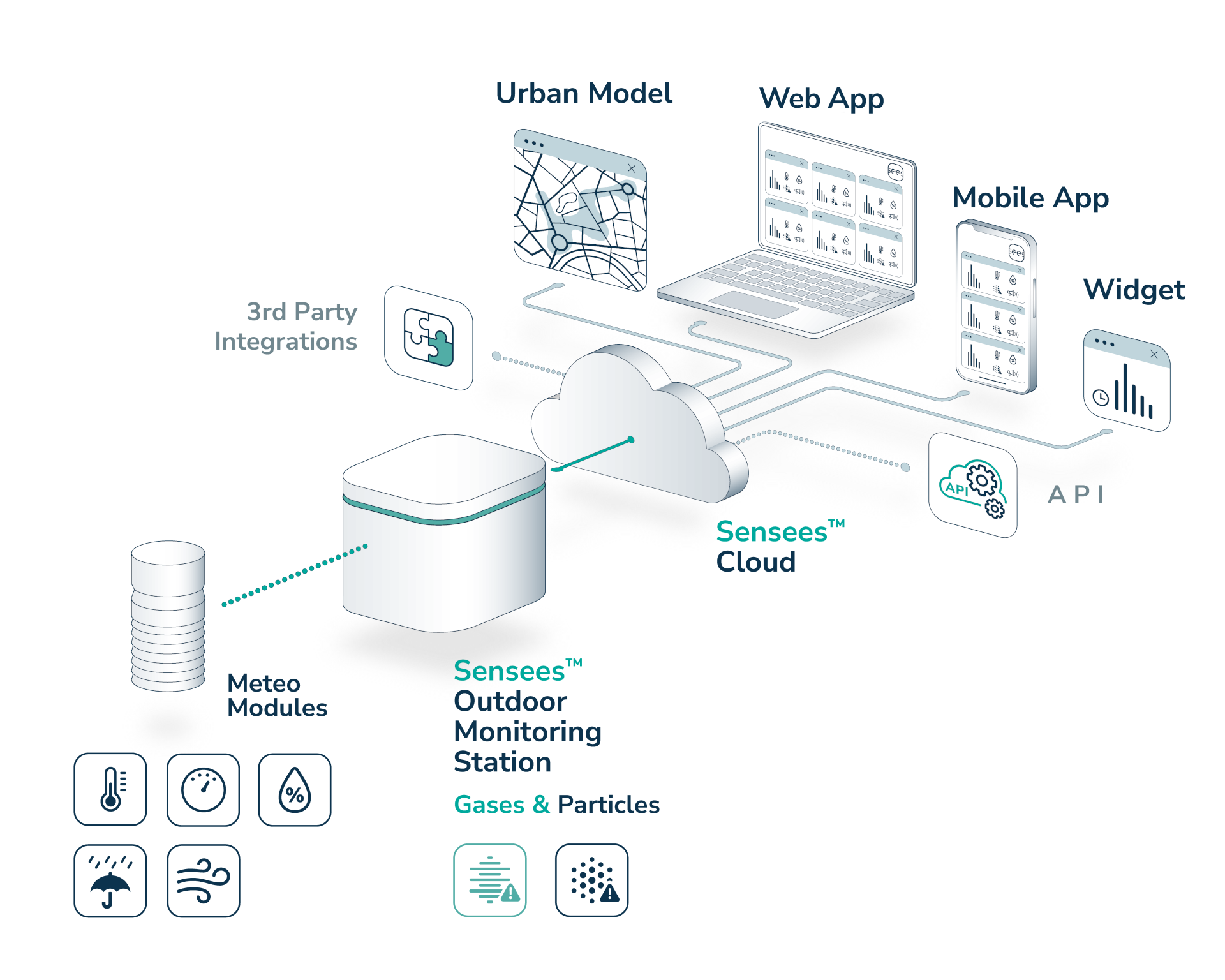There's something in the air...
Track what it is.
Weather plays a crucial role in influencing pollution levels in the
atmosphere. Track and measure temperature, wind speed, humidity and
pressure with Sensees solution for effective air quality management.
Why should we monitor
weather parametres?
Understanding how different weather parameters interact with pollution sources and affect air quality is important for effective air quality management. Looking at the sky won’t help, we need accurate and real-time data to know what is really happening.
How does weather impact air quality?
Creation and dispersion of pollutants
Some factors increase the rate of chemical reactions in the
atmosphere and the formation of pollutants, while others
help dispersing pollutants.
Complex interactions
Different metereological parametres factors often interact in
complex ways to influence air quality. For example, during a
temperature inversion, pollutants trapped near the surface
may be further concentrated due to stagnant air conditions.
Seasonal Variations
Air quality can vary seasonally due to changes in these
meteorological parameters. For instance, winter inversions
can lead to higher levels of particulate matter in urban areas.
Creation and dispersion of pollutants
Some factors increase the rate of chemical reactions in the atmosphere and the formation of pollutants, while others help dispersing pollutants.
Complex interactions
Different metereological parametres factors often interact in complex ways to influence air quality. For example, during a temperature inversion, pollutants trapped near the surface may be further concentrated due to stagnant air conditions.
Seasonal Variations
Air quality can vary seasonally due to changes in these meteorological parameters. For instance, winter inversions can lead to higher levels of particulate matter in urban areas.
Monitoring weather parameters helps making better air
quality management strategies, such as implementing
emission controls during unfavorable weather conditions.
Did You Know?
...that presence of harmful gases and particles in the atmosphere results in 7M premature deaths globally each year.
World Health Organization
Which weather factors to track
Learn how different weather parameters impact pollution:
Temperature
Real-Time data: With real-time data monitoring systems help with early detection of pollution spikes or hazardous conditions. This allows authorities to issue warnings when air quality deteriorates.
Health protections: Individuals, especially those with respiratory conditions, can take precautions and adjust their activities (e.g., outdoor exercise) to minimize exposure.
Optimize the deployment of medical resources and staff to areas expected to be most affected.
Help emergency services and hospitals prepare for potential increases in patients with respiratory or cardiovascular issues.
Wind speed and direction
Wind plays a significant role in dispersing pollutants. Higher wind speeds can help disperse pollutants away from their sources, reducing local concentrations. Wind direction determines where pollutants are carried, impacting air quality in downwind areas from pollution sources.
Humidity
Humidity levels affect the formation and concentration of certain pollutants. For example, high humidity can contribute to the formation of particulate matter (PM) by facilitating the condensation of water vapor around particles. On the other hand, low humidity can intensify the effects of air pollutants like ozone.
Rain
Rain can help cleanse the atmosphere by washing out pollutants. This process, known as wet deposition, can remove particles and soluble gases from the air. However, precipitation can also lead to the formation of acid rain in areas with high levels of air pollution.
Atmospheric pressure
Changes in atmospheric pressure can influence the vertical mixing of air masses. High-pressure systems can trap pollutants near the ground, leading to poor air quality conditions. Low-pressure systems, on the other hand, promote vertical mixing and can help disperse pollutants.
In summary, temperature, wind, humidity, rain, and atmospheric pressure are integral components of the atmospheric system that significantly influence the distribution, concentration, and chemical transformation of pollutants in the air we breathe.
Noise monitoring can help you fight the unhealthy noise pollution in your city. By detecting noise sources, measuring and analyzing noise levels, and offering tailored management solutions across diverse environments, it enables effective mitigation strategies.
Urban Air Pollution Monitoring
Better understanding of pollutant dispersion, timely air quality warnings, policy development.
Urban Planning and Development
Improved building designs, efficient energy use, reduced urban heat islands.
Environmental Research
Improved climate models, informed policy-making, understanding of global warming effects.
Industrial Emission Monitoring
Helps industries comply with environmental regulations by monitoring emissions.
Our Partners & Clients

















What our Clients say about us?

Matijana Jergović
M.D., PhD., Primarius, Epidemiologist and Environmental Health Specialist Dr. Andrija Štampar Institute of Public Health
The development of innovative tools for „user friendly“ display of the complex air quality monitoring in spatio-temporal mode with modelling function is extremely important for the air quality health impact assessment, due to the acute but also delayed health outcomes. The development of comprehensive digital infrastructure will make it easier to compare environmental indicators of air quality with health indicators – in order to assess and give recommendations for corrective and preventive measures as accurately as possible.

Goran Škvarč
Deputy CEO for International Cooperation at CARNET
By enabling teachers to have insight into the air quality in the classroom, the AERO system enhances the quality of the teaching process at its core. Teachers get informed at any moment if the air flow in the room is reduced, thereby maintaining an optimal concentration level. This way, CARNET AERO contributes to making schools a pleasant place to stay where every factor affecting the teaching process can be analysed and improved.

Marjana Senčar Srdič
Research and Strategic Development Consultant, A1 Slovenia
At A1 Slovenia, we’re excited to partner with Smartsense, whose Sensees Environment platform has revolutionized our air quality management. Their cutting-edge technology tracks multiple air parameters, empowering citizens and institutions to take proactive steps for better air quality. This collaboration supports our commitment to sustainability and smarter cities.

Goran Matoš
Senior Telecom Infrastructure Architect, Network Transformation Division, A1 Hrvatska d.o.o.
The Energee Meter has revolutionized how we monitor energy consumption at each base station! We were impressed by the quick, simple installation, enabling swift responses to future needs. The cloud-based dashboard provides rich insights for detailed analysis, while the API interface makes it easy to gather data for advanced comparisons with our telecom network. Working with Smart Sense’s talented team is always a pleasure!

Milan Parat
Executive Director of Corporate Security, Privredna banka Zagreb dd
By using Smart Sense solutions for indoor air quality monitoring, we gained valuable and timely information that we used to ensure an optimal microclimate in our offices, aiming to reduce potential health risks associated with working together in enclosed spaces.

Dragan Vulin
Deputy Mayor of Osijek
As a long-time user of Sensees air quality monitoring solutions in the City of Osijek, we are extremely satisfied with the quality of information the system provides. The hardware solution is robust and does not disrupt the urban landscape of our city, while the application allows us to handle all relevant data on air quality, weather conditions, and noise levels—all in real time. By monitoring air quality, we ensure a healthy living environment for our citizens, and we are ready to respond quickly in the event of unforeseen environmental disruptions.

Tomislav Babić
Headmaster - Lucijan Vranjanin High School
The motivation for installing Sensees Indoor sensors was to monitor classroom conditions during lessons and state exams in early summer. With long-standing issues of high temperatures in classrooms, I wanted to track temperature and CO2 levels to find optimal solutions. The easy-to-use software provides daily insights, helping detect issues and improve learning conditions, leading to better student focus, results, and energy savings.

Andreas Economides
The Cyprus Telecommunications Authority (CYTA) Partnerships and New Ventures Coordinator Vertical Markets
It was a pleasure working with Smart Sense on the Nicosia Smart City project providing high quality environmental sensors. Their dedication to quality, attention to detail, and exceptional collaboration made the entire process seamless from start to finish. They consistently met project deadlines, provided expert insights, and maintained clear and open communication throughout. The level of professionalism demonstrated was remarkable, and their innovative approach helped us overcome challenges and deliver a successful outcome. We look forward to future collaborations and highly recommend their services for similar projects.

Željko Turk
Mayor of Zaprešić
We always strive to provide our citizens with technology that truly makes a difference and elevates the quality of life. That’s exactly why we chose Smart Sense. We are extremely pleased with the installation of Sensees Indoor sensors in all our schools and kindergartens, as well as Sensees Outdoor stations for monitoring outdoor air quality. These sensors provide us with valuable insights into air quality, helping us ensure healthier environment for our children and fellow citizens. The data we receive allows us to make timely, informed decisions. We are very satisfied with the positive impact these projects have on our community
Case studies
Learn how others have improved their lives and work productivity by implementing Environmental monitoring systems in their cities, companies or homes.






